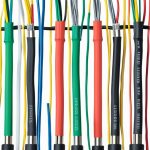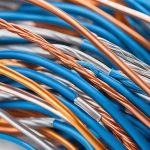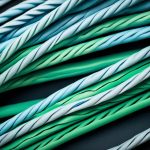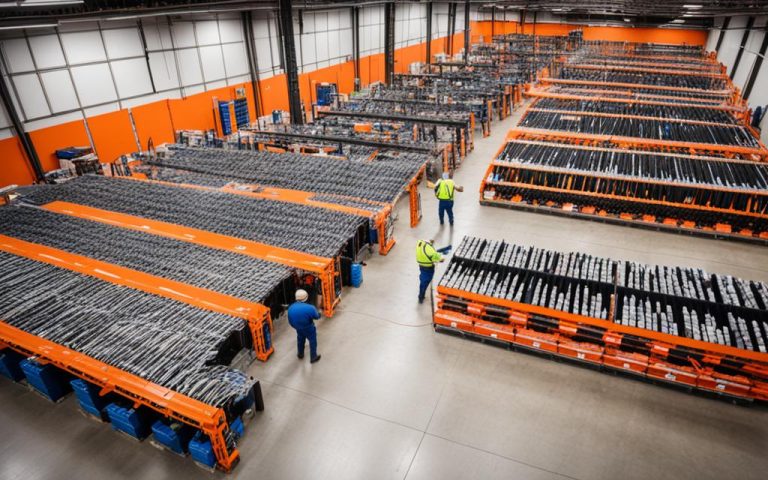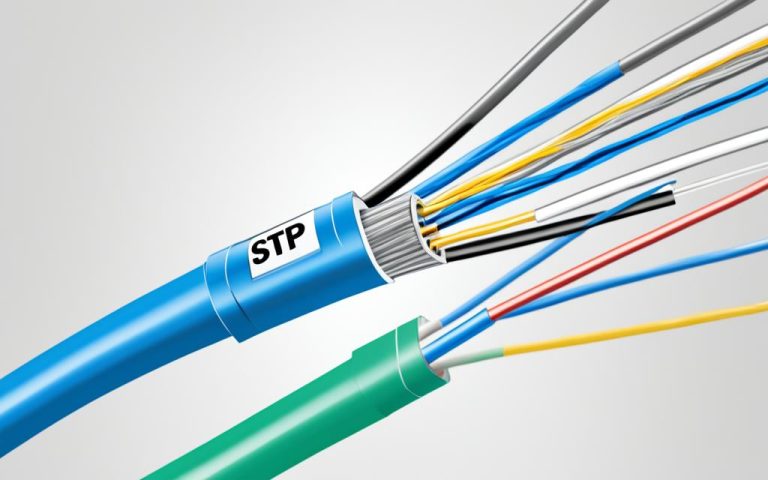Welcome to our article on promoting sustainability in twisted pair cable usage. As technology evolves and businesses become more environmentally conscious, the demand for eco-friendly networking solutions is on the rise. In this section, we will explore the benefits of eco-friendly twisted pair cables and their role in sustainable networking.
Eco-Friendly Twisted Pair cables are a key component of environmentally conscious networking. These cables, made of pairs of insulated copper wires, provide reliable and efficient connectivity while reducing the carbon footprint. By minimizing electromagnetic interference and crosstalk, they ensure high-quality communication in various applications such as LANs, Ethernet networks, DSL lines, telephone lines, and security camera systems.
Twisted pair cables come in different categories, including Cat5e, Cat6, Cat6A, and Cat8, offering flexibility and scalability for different network installations. Whether it’s unshielded (UTP) or shielded (STP) cables, the use of twisted pair cables provides several advantages over coaxial cables, including lower cost, easier installation, and support for high transmission rates.
As businesses seek sustainable solutions, eco-friendly networking solutions such as twisted pair cables play a crucial role. They not only help reduce the impact on the environment but also comply with regulations and attract environmentally conscious subscribers.
In the next section, we will delve deeper into the growing market for shielded twisted pair (STP) cables and highlight the market trends driving the adoption of sustainable networking solutions.
The Growing Market for Shielded Twisted Pair (STP) Cables
The Shielded Twisted Pair (STP) Cable market is experiencing significant growth, driven by technological advancements, increasing consumer awareness of sustainability, and government policies promoting environmentally friendly alternatives. By leveraging sustainable solutions, the market is poised for substantial growth and development.
With the rise of technological advancements, the demand for high-quality network cables has increased. As a result, key sectors such as construction, automotive, and electronics are witnessing a surge in demand for STP cable products. This growth is fueled by ongoing investments in research and development that aim to enhance the quality and performance of STP cable offerings.
Furthermore, consumer awareness of sustainability has played a crucial role in driving the market forward. As more consumers prioritize eco-friendly products, the demand for shielded twisted pair cables has seen a significant boost. This growing consumer awareness has prompted manufacturers to develop sustainable solutions that align with environmental considerations.
Government policies promoting environmentally friendly alternatives have also played a pivotal role in shaping the market landscape. Regulatory measures and financial incentives have encouraged businesses to adopt sustainable practices, including the use of shielded twisted pair cables. By complying with government policies, businesses not only contribute to a greener future but also benefit from cost savings.
These sustainable solutions not only help reduce the carbon footprint of telcos but also contribute to the overall growth and development of the market. By embracing environmentally friendly alternatives, businesses can attract eco-conscious consumers and comply with regulations, ultimately boosting their bottom line.
To further illustrate the market growth and potential, consider the following table showcasing the expected valuation and projected CAGR:
| Year | Valuation ($) | Projected CAGR (%) |
|---|---|---|
| 2022 | XX,XXX,XXX | XX% |
| 2023 | XX,XXX,XXX | XX% |
| 2024 | XX,XXX,XXX | XX% |
| 2025 | XX,XXX,XXX | XX% |
| 2031 (Projected) | XXX,XXX,XXX | XX% |
As seen in the table, the Shielded Twisted Pair (STP) Cable market is expected to reach a significant valuation by 2031, with a projected CAGR during the forecast period. This growth highlights the market’s potential and the increasing demand for sustainable networking solutions.
Telcos Embracing Sustainability Initiatives
Telcos worldwide are taking significant steps to reduce their carbon footprint and embrace sustainability initiatives. These initiatives encompass various strategies aimed at maximizing energy efficiency, optimizing network infrastructure, and adopting greener practices throughout their operations. By prioritizing Telco sustainability, companies are not only reducing their environmental impact but also reaping several benefits, including cost savings and improved brand reputation.
Copper Wireline Switch Off
One of the key strategies implemented by telcos is the switch off of copper wirelines in favor of more efficient and eco-friendly fiber optic cables. This transition offers several advantages, such as:
- Reduced energy consumption: Fiber optic cables require less power compared to traditional copper wirelines.
- Improved reliability: Fiber optic cables offer superior signal quality and are less susceptible to interference.
- Fewer field service calls: Fiber optic cables have a longer lifespan and require fewer repairs, resulting in reduced maintenance costs and environmental impact.
3G Wireless Switch Off
Telcos are also phasing out 3G wireless networks, which consume more energy compared to newer technologies like 4G and 5G. By shutting down these networks, telcos can achieve significant energy cost savings, reduce carbon emissions, and pave the way for more efficient and sustainable wireless connectivity. The transition to 4G and 5G networks not only benefits the environment but also improves network performance, enabling faster data speeds and better user experiences.
Greener Field Service Fleets
Telcos are making their field service fleets greener by adopting electric and hydrogen-powered vehicles. By transitioning from traditional fossil fuel vehicles to more sustainable alternatives, telcos can significantly reduce emissions and minimize their environmental impact. The use of greener fleets also helps companies comply with stricter emission regulations, improve air quality in communities, and showcase their commitment to environmental stewardship.
Greener 5G Gear
Advancements in 5G gear are enabling telcos to achieve significant energy savings and minimize their carbon footprint. New technologies, such as energy-efficient hardware and AI algorithms, allow 5G equipment to intelligently optimize power consumption by entering sleep mode when not in use. This not only reduces energy waste but also helps telcos operate more sustainably and economically.
To summarize, telcos are fully committed to sustainability, implementing various initiatives to reduce their carbon footprint and embrace greener practices. By phasing out copper wirelines, switching off 3G networks, adopting greener field service fleets, and utilizing energy-efficient 5G gear, telcos are leading the way towards a more sustainable future in the telecommunications industry. These efforts not only benefit the environment but also position telcos as responsible corporate citizens, attracting environmentally conscious customers and contributing to a greener, more sustainable society.

The Future of Eco-Friendly Twisted Pair Cables
The future of eco-friendly twisted pair cables holds great promise, driven by ongoing advancements in technology and a strong emphasis on reducing power consumption. As the market continues to evolve, twisted pair cables are expected to become even more efficient and versatile, offering sustainable solutions for various industries. In the quest for sustainability, innovations in materials, manufacturing processes, and digital technologies are propelling the development of more eco-friendly and energy-efficient twisted pair cable solutions.
One of the key areas of focus is power consumption reduction. Manufacturers are investing in research and development to design cables that consume less energy without compromising performance. These advancements not only benefit the environment by reducing carbon emissions but also contribute to significant cost savings for telecommunication companies (telcos).
With the introduction of second-generation 5G gear, telcos can expect substantial reductions in power consumption, especially during periods of low network traffic. By leveraging new technologies and intelligently managing power usage, telcos can achieve greater energy efficiency and optimize their network resources. This not only aligns with sustainable practices but also enhances the overall service quality for customers.
Advancements in Technology
The future of eco-friendly twisted pair cables is closely tied to advancements in technology. Continuous research and development efforts are driving the exploration of new materials that offer improved conductivity, durability, and environmental friendliness. These advancements aim to enhance cable performance while minimizing the use of non-renewable resources.
Digital technologies are also playing a significant role in improving the efficiency and sustainability of twisted pair cables. Smart manufacturing processes, such as automation and machine learning, enable manufacturers to optimize resource utilization, reduce waste, and streamline production. Additionally, digital monitoring and diagnostic capabilities allow for proactive maintenance and troubleshooting, maximizing the lifespan and performance of the cables.
The Importance of Efficiency
Efficiency is a key aspect of sustainable solutions, and it remains a top priority in the development of eco-friendly twisted pair cables. Manufacturers are constantly exploring new techniques to minimize signal loss, cross-talk, and interference, thereby increasing the overall efficiency of the cables.
Efficiency improvements in twisted pair cables directly translate to reduced power consumption. By minimizing energy losses during transmission, telcos can lower their carbon footprint and operational costs. Additionally, efficient cables require less maintenance and replacement, resulting in further cost savings for telcos and a decreased environmental impact.
The Path to a Sustainable Future
The future of eco-friendly twisted pair cables lies in the continued pursuit of sustainable solutions, advancements in technology, and a collective commitment to reducing power consumption. By embracing environmentally conscious practices and leveraging the latest innovations, telcos can contribute to a greener future while meeting the increasing demand for efficient and reliable networking solutions.
| Advancements | Benefits |
|---|---|
| New materials | Improved conductivity and durability |
| Digital technologies | Optimized manufacturing processes, proactive maintenance |
| Efficiency improvements | Reduced power consumption, lower operational costs |
Through a combination of innovation, efficiency, and sustainability, the future of eco-friendly twisted pair cables holds immense potential in meeting the evolving needs of industries and ensuring a greener and more connected world.

Conclusion
In summary, eco-friendly twisted pair cables provide sustainable networking solutions for various industries. Whether unshielded or shielded, these cables offer reliable and efficient connectivity while reducing environmental impact. Telcos worldwide are actively embracing sustainability initiatives and implementing strategies such as the switch-off of copper wirelines, 3G wireless networks, and the use of greener field service fleets. As advancements in 5G gear and future trends in twisted pair cables continue, the focus remains on reducing power consumption and enhancing efficiency.
The key takeaways from this discussion are the importance of promoting sustainability in the telecommunications industry, complying with regulations, attracting subscribers, and contributing to a greener future. By adopting eco-friendly networking solutions, telcos can meet the growing demand for environmentally conscious options while achieving their business objectives. It is evident that sustainable practices in twisted pair cable usage are not only beneficial for the environment but also for the industry and its stakeholders.
In conclusion, sustainable networking solutions through the use of eco-friendly twisted pair cables hold great promise. With a commitment to reducing environmental impact and embracing technological advancements, telcos can play a significant role in creating a greener and more sustainable future.
FAQ
What are twisted pair cables?
Twisted pair cables are pairs of insulated copper wires twisted together, which are widely used for telephone communications and Ethernet networks. They offer advantages such as reduced electromagnetic interference and crosstalk.
What are the different categories of twisted pair cables?
Twisted pair cables come in different categories, including Cat5e, Cat6, Cat6A, and Cat8. Each category has varying specifications and capabilities.
What is the difference between UTP and STP cables?
UTP cables are unshielded and are cheaper and lighter, while STP cables are shielded and provide better protection against electromagnetic interference.
What are the applications of twisted pair cables?
Twisted pair cables are used for various applications such as LANs, Ethernet networks, DSL lines, telephone lines, and security camera systems.
Why are twisted pair cables preferred over coaxial cables?
Twisted pair cables offer advantages over coaxial cables, including lower cost, easier installation, and support for high transmission rates over LANs and Ethernets.
What are CAT6 STP cables used for?
CAT6 STP cables are a category of shielded twisted pair cables that are particularly suited for network cabling in environments with high external interference.





